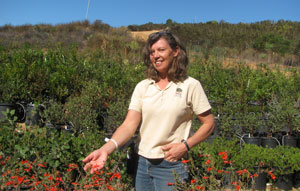11/22/2011
Natives Know-How
Pam Buddy-D’Ambrosio

Fifteen years ago, Su Kraus could have never imagined, as a native of England with no horticulture background, that she would be the owner and nursery manager of a California native plant business.
Su and her husband, Hank, purchased 20 acres one hour northeast of San Diego in Valley Center, California, with plans to build a house. When Su and Hank cleared the land that had been used unsuccessfully to grow avocados, they landscaped with only native California plants. A small creek runs through the property, which connects with the larger Moosa Creek, for which the nursery is named.
“The creek bed was a mess; we started restoring the riparian area and propagating the Coast Live Oaks, then added more species,” Su says. “The original idea was to keep [the propagation] small, but it evolved into a business; the nursery leap-frogged our plans.”
In 2004, Su says there weren’t many growers in the native plant business. She learned about natives through potential customers, experts and garden center personnel who were willing to share information. She found an abundance of material in literature, on-line resources, the native plant society and non-profit organizations.
Su says, “Our family loves to hike, so we are able to observe the native areas and the growth patterns. We did propagation through trial and error, but also from observing the habits in the wild and imitating the conditions. The best parts of the job are looking at plants in the native environments and collecting seeds.” Most of the seeds come from their property; additional seeds are purchased from a major native seed supplier.
The nursery is on one quarter of the 20 acres with about 40,000 sq. ft. under cover. Su says one side of their property is native chaparral. “We are in the hills in a rural area about 30 minutes from Palomar Mountain. It’s not an ideal growing ground—it’s too steep—we sometimes dream of a large flat area,” she says.
Su grows 300 species of natives, including a number of her favorites such as native lilacs, salvias, Matilija poppy—anything that increases the wildlife in the area. “We found that native plant growers and sellers were far away from homeowners. We want to make it accessible for the public to use native plants,” Su says.
Moosa Creek Nursery sells only wholesale and partners with handpicked retail nurseries in the area. The partnerships originate through online research and meetings with the nursery managers. Su ensures that the retailer is philosophically aligned with Moosa Creek’s vision for California natives. “We’re selective with our partners. Native plants can’t be handled the same way as ornamentals. They can’t be overwatered,” says Su. Once they agree to work together, Su requests a suitable square footage in a good location in which to display 40 native plants grown by Moosa Creek Nursery.
The nursery partners with seven retailers in San Diego County and three in Riverside County, all within a 100-mile radius. Any customer of the retailers can go online to Moosa Creek Nursery’s website to place an order for delivery to one of the 10 retailers. It’s risk-free for the retailers as they call the customers to pick up the plants once they’re delivered. For the retailer, since there’s a fast turnaround on the plants, there’s no need for a large inventory space for an extended time. Moosa Creek’s driver merchandises the plants according to the time of year. “We guarantee all plants, credit the retailers when necessary, provide them signage and material with plant care information and POS materials—we give the whole package so the customer is happy,” says Su.
Two more ways that Moosa Creek Nursery gets natives in the ground is by working with commercial landscape contractors and with restoration projects. For restoration, the nursery provides native plants suited to particular habitats, and also provides mitigation from development. One of the first jobs they completed was on the grounds of a casino built on Native American tribal land, which had been stripped of vegetation and all native plants. “We helped with plant selection and monitoring,” says Su.
While at a farmers market, a Moosa Creek Nursery representative met Kristie Orosco, Director of Environmental Protection and Compliance for the San Pasqual Band of Mission Indians. Kristie has been instrumental in restoring and revitalizing customs and the ways of life of the indigenous tribes. The tribal land restoration work came about at the same time that Su was looking for projects that coincided with her efforts of sustainability and her desire to be a business model for others: leave a light footprint, be socially responsible, have a positive impact on everyone the business touches—customers and employees.
Su speaks highly of Moosa Creek Nursery’s six employees: grower, propagator, nursery supervisor, and the merchandising, production and maintenance specialists. The accolades are extended to Su’s husband, Hank, who has a full-time job, but helps at the nursery as “part-time gopher.” “We’re very fortunate to have hard-working, dedicated people,” says Su.
Tips for other growers:
- “Since growing doesn’t have a high profit margin, you might as well be happy!”
- “Focus on what you’re good at and market the areas that other nurseries don’t supply.”
- “Keep challenging yourselves. My challenge is working hard on the techniques to grow Woolly Blue Curls, which is difficult to propagate.”
- “Treat your employees like family and your customers like friends.” GT
Pam Buddy-D’Ambrosio is a freelance writer in New Rochelle, New York.